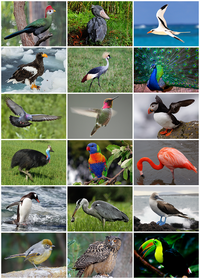
Photo from wikipedia
Aim. The diversity of brood size across animal species exceeds the diversity of most other life history traits. In some environments, reproductive success increases with brood size, while in others… Click to show full abstract
Aim. The diversity of brood size across animal species exceeds the diversity of most other life history traits. In some environments, reproductive success increases with brood size, while in others it increases with smaller broods. The dominant hypothesis explaining such diversity predicts that selection on brood size varies along climatic gradients, creating latitudinal fecundity patterns. Another hypothesis predicts that diversity in fecundity arises among species adapted to different microhabitats within assemblages. A more recent hypothesis concerned with the consequences of these evolutionary processes in the era of anthropogenic environmental change predicts that low-fecundity species may fail to recover from demographic collapses caused by rapid environmental alterations, making them more susceptible to extinctions. These hypotheses have predominantly been addressed in endotherms, and only rarely in other taxa. Here, we address all three hypotheses in amphibians globally. Location. Global. Time period. Present. Major taxa studied. Class Amphibia. Methods. Using a dataset spanning 2,045 species from all three amphibian orders, we employ multiple phylogenetic approaches to investigate the association between brood size and climatic, ecological, and phenotypic predictors, and against species conservation status. Results. Brood size increases with latitude. This tendency is much stronger in frogs, where temperature seasonality is the dominant driver, whereas salamander fecundity increases towards regions with more constant rainfall. These relationships vary across continents, but confirm seasonality as the key driver of fecundity. Ecologically, nesting sites predict brood size in frogs, but not in salamanders. Finally, we show that extinction risk consistently increases with decreasing fecundity across amphibians, whereas body size is a ‘by-product’ correlate of extinction given its relationship with fecundity. Main conclusions. Climatic seasonality and microhabitats are primary drivers of fecundity evolution. Our findings that low fecundity increases extinction risk reinforces the need to re-focus extinction hypotheses based on a suggested role for body size.
Journal Title: Global Ecology and Biogeography
Year Published: 2021
Link to full text (if available)
Share on Social Media: Sign Up to like & get
recommendations!